Life of Pi Film Review
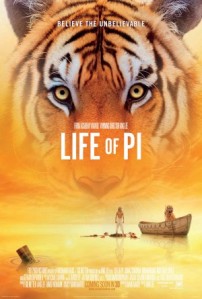 Now that we’ve blown past the summer solstice (or winter’s for those down under), the second half of the year is just over the horizon. Like some distant ship barely coming into view of a castaway set adrift. Here’s hoping what’s left of 2016 is not some oil tanker or container ship set on a high seas collision course right for us. The Scientist Gone Wordy and I may not notice as we’re distracted by this month’s serial book-film duo post already in our sights.
Now that we’ve blown past the summer solstice (or winter’s for those down under), the second half of the year is just over the horizon. Like some distant ship barely coming into view of a castaway set adrift. Here’s hoping what’s left of 2016 is not some oil tanker or container ship set on a high seas collision course right for us. The Scientist Gone Wordy and I may not notice as we’re distracted by this month’s serial book-film duo post already in our sights.
The wordy one will look at the enthralling novel by Yann Martel published in the pivotal period of September 2001. Life of Pi, a survival tale cleverly marooned within adventurous fantasy, was rejected by a number of publishing houses before Knopf Canada believed in it. Which then sold ten million copies worldwide. I’ll review its “unfilmable” adaptation of a precocious Indian teen and his ferocious mate lost at sea that took years of a famed Taiwanese filmmaker’s career to bring to a Cameronesque result.
The wordy one’s book review can be found here:
A brief synopsis of the film: The son of a zookeeper with an unusual name, Piscine Molitor “Pi” Patel has grown up among a variety of animals under his father’s care in Pondicherry, India. Religions, as well, as he’s become a dedicated Hindu, Christian, as well as a follower of Islam. To the consternation of his secularist dad and traditional family household, who will eventually pack up to leave their homestead for another land.
The sixteen-year-old will need all his encyclopedic knowledge of animals and the spiritual to survive the shipwreck that’s taken the lives of his loved ones and most of the zoo animals they were to deliver on their journey to a new Canadian home. Especially since he shares a lifeboat with one Richard Parker…a 450 pound Bengal tiger. Their 227 days of mutual survival revealed by an adult Pi to the novelist looking to hear a remarkable story.
[spoiler warning: some key elements of the film could be revealed in this review]
“I suppose in the end, the whole of life becomes an act of letting go, but what always hurts the most is not taking a moment to say goodbye.”
When Rachel disclosed her list of titles we’d review for the year months ago, was not surprised she’d index a fairly recent one. She’s not stuck in the past like you-know-who. Life of Pi one of those I elected to skip in 2012 on its theatrical first-run for later home viewing. I’ve grown to regret that choice over the last few years after I did just that. “3-D” fatigue caused by its gimmicky overuse through the years by most of the major studios likely behind the decision.
Anyway, that’s my story and I’m sticking to it.
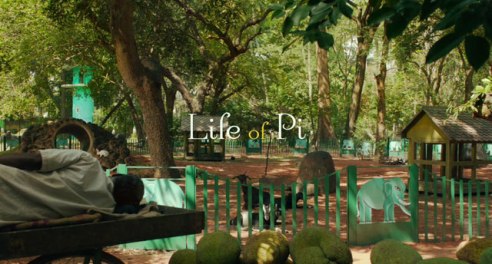
Admittedly, this was one of those I found hard to review, being as allegorical as the story is. Chiefly, now after reading the source and comparing it to its adaptation the second time around. Technically, it’s an amazing, eye-catching work that dazzles in telling its survivor tale. The enchantment of India, proffering a brief sampling of its culture, via an intrepid youth put through a wondrously arduous journey to stay alive in an extraordinary environment and setting.
His months-long existence distilled down to 127 minutes sketched across the largest body of water the planet has to offer that’s both an unnamed character of the film witnessing the struggle and completely indifferent to it all.
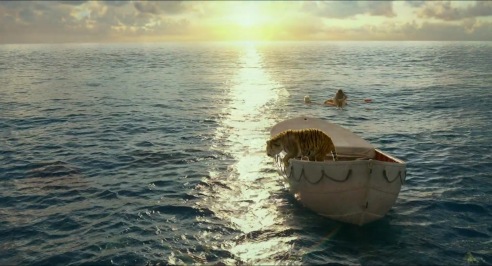
Known for his epic (Crouching Tiger Hidden Dragon) and small projects (Eat Drink Man Woman, Brokeback Mountain), director Ang Lee once again pulled off a remarkably intimate work. Bringing Pi to Life on the screen, whichever one you may have used. No matter the scale — the expanse related by the teen and adult versions of our hero never loses a beat no matter who’s doing the talking. Ang painted with visual majesty on a virtually limitless canvas at times, but shyly when the nitty got too gritty1.
Yes, Yann Martel’s yarn2 is about that troublesome concept known as faith. Either you’ll find reassurance in the author’s uniquely metaphysical redux of ‘Jonah and the Whale’, juxtaposed with a castaway Rudyard Kipling would have been more than comfortable with, or you won’t. Seeing what The Thorn Birds‘ Father de Bricassart believed in a merciful God sustaining the faithful no matter what tribulation thrown their way. Or, wondering as Meggie Clery did about who let the ship sink in the first place.
Beauty in being alive, and in your suffering.
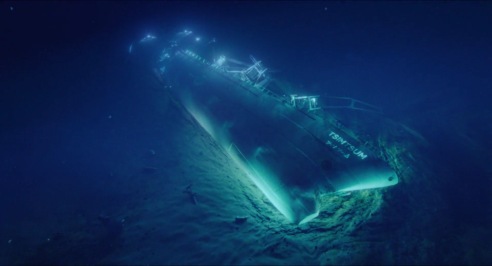
Reading the novel, you could see why producers thought it “unfilmable.” A watery, stranded story has been done from Hitchcock to Zemeckis, featuring clever wit to bleak desperation, and everything in-between just to stay alive and get back home. But putting a majestically dangerous creature like a tiger on board, and make it believable as well as compelling as the author’s lead would have been too much for most filmmakers, animal trainers, and movie special effects. At least in 2000 or earlier.
Luckily for movie audiences, producers waited for both Ang Lee to come available, which was after James Cameron’s Avatar and the more mature 3-D and computer graphics he pioneered to bring it in. Made this production even part-way conceivable, and still it took four long years of the director’s life to “engineer.” Let alone CGI a credible tiger. Add in Lee’s Taiwan giving their hometown hero a portion of a retired jet runway to build the largest water tank known till then and you can see why I used the term “Cameronesque” earlier.
“No one has seen that island since, and you’d never read about those trees in any book. And yet, if I hadn’t found those shores I would have died, if I hadn’t discovered that tooth I would have been lost alone forever. Even when God seemed to have abandoned me, he was watching. Even when He seemed indifferent to my suffering, He was watching and when I was beyond all hope of saving… He gave me rest and gave me a sign to continue my journey…”

Yet, impressive effects only go so far without cast performances to give it a bearing. Delightfully, filmmakers embraced Asian performers to carry this forth. Primarily through Irrfan Khan, one of India’s greatest, as the adult Pi who introduced the story, with the outstanding film debut of Suraj Sharma to do the heavy-lifting as the allegorical “π” left to determine the diameter of the Pacific3. A smallish cast, including Adil Hussain as his father Santosh Patel, Tabu as his mother, and others, but they make the most of their brief time4.
“So which story do you prefer?”
Thank Vishnu5, Life of Pi never attempted to anthropomorphize the animals keen to the tale. The wild remain that, if habituated to their surroundings for survival’s sake. Furthermore, even the spiritual is offered credible doubt when explanations for enduring such a feat present a narrative analogy too terrible to contemplate. Credit Claudio Miranda‘s cinematography for capturing all of those small and large moments with equal measure while Mychael Danna‘s film score buoyed our hearts throughout when needed most.
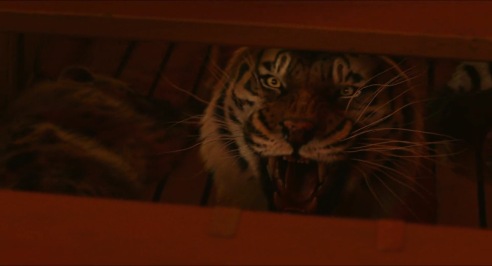
Digitally rendering animals realistically6 (there are only brief three instances of a real-life tiger onscreen) can be distracting, but Lee and crew ultimately made it matter-of-fact in that way artists use the ingredients at hand in constructing a work of art. At no time did the director let the dint of digital overwhelm what was the essentially an analogue of Martel’s creative work. In this day and age where studios constantly reach for formulas to fabricate box office, Life of Pi was a breath of fresh air…or should I say potable water.
Parallel Post Series
- Deliverance
- The Laughing Policeman
- The Joy Luck Club
- Like Water For Chocolate
- Edge of Tomorrow
- – 2015 posts
- – 2014 posts
- – 2013 posts
- – 2012 posts
- – 2011 posts
- – 2010 posts
- Although, the novel had no hesitancy in showing tooth and nail violence, bloody viscera or bodily function for those facing life or death moments in such a story, screenwriter David Magee’s adaptation definitely a PG-rated endeavor. The first family film to win a director’s Oscar since Oliver (1968), in fact. ↩
- “Author Yann Martel said he was inspired by a book review of Brazilian author Moacyr Scliar‘s 1981 novella Max and the Cats, about a Jewish-German refugee who crossed the Atlantic Ocean while sharing his boat with a jaguar.” ~ IMDB ↩
- In the 227 days represented, the figure also refers to the mathematical constant that is Pi when expressed as an approximate fraction, or 22/7. ↩
- French actor Gérard Depardieu has a brief scene onboard the doomed ship as the cook. I speculate he contributed more as this quite dark character from the novel, but likely those were either cut or never filmed to maintain the family film it ended up as. ↩
- “Several shots include the profile view of a supine Vishnu (the sleeping Hindu God seen in the barge). He appears in the distant hills when Pi is on holiday and visits the church to drink the holy water. He appears in clouds on a dark night at sea. He is in the shape of the Marianas Trench on the oceanic map. He is also the carnivorous island in profile.” ~ IMDB ↩
- Not to say the rendered digital effects were perfect; there are moments where the birds and animals are obviously CGI. Breaking some of the mystique and allure of the moment, but these were rare and didn’t stick out sorely like some. ↩

16 Responses to “Life of Pi Film Review”
I love the religious themes, the CGI (a rarity for me), the beautiful world — especially the underwater sequence and the neon fish and the whale. The animal kingdom comes alive throughout and man is but a lonely traveler in it. Nice post, you two!
LikeLiked by 1 person
Did you see it in the theater with 3-D? I’m going to have to keep an eye for a revival screening for any chance to catch this the way it was meant to be seen. Thanks, Cindy.
LikeLike
This film is very deep and beautiful. I’d love to see it in 3-D. Every time I watch it I catch something new.
LikeLiked by 1 person
Yeah, if given the opportunity to see this in a big 3-D screening, I’d jump at the chance.
LikeLiked by 1 person
I liked Life of Pi but I didn’t love it like so many did. I appreciate the themes it handled and the visuals, but it didn’t all click for me. That said, I have been meaning to give it another look.
LikeLiked by 1 person
I think I enjoyed much more a second time — ‘course, that was after I read the source material. Thanks so much, Keith.
LikeLike
I guess I’m just gonna take your word for it since I didn’t (and won’t) watch it. 🙂 I do appreciate you doing this one that I’ve got a film embargo on. I had a great time re-reading the book.
cheers.
LikeLiked by 1 person
I know…I know. 😉
Great book to read and glad to picked it for this, Rachel. I’d probably not put it in my reading stack, otherwise. Thanks! 🙂
LikeLike
Beautiful review! This was a visual masterpiece, but the story is also emotionally involving with a thought provoking message. I always appreciate Ang Lee as a visionary filmmaker who can tackle so many different genres. This one is such an eye and ear candy too!
LikeLiked by 1 person
Thank you very kindly, Ruth. It is a visual stunner. Found it immersive, but probably would have more so, if I’d see it on the big screen 3-D. 🙂
LikeLiked by 1 person
The ship sinking scene still remains a tour de force, although I can kinda take or leave the rest of it. Your appraisal is nevertheless heartfelt and I applaud you for it!
LikeLiked by 1 person
That is quite the sequence, and very fair distillation from the novel of those scenes, too. Thank you very much, Mark. Much appreciated. 🙂
LikeLiked by 1 person
[…] Life of Pi […]
LikeLike
[…] Life of Pi […]
LikeLike
[…] Life of Pi […]
LikeLike
[…] Life of Pi […]
LikeLike